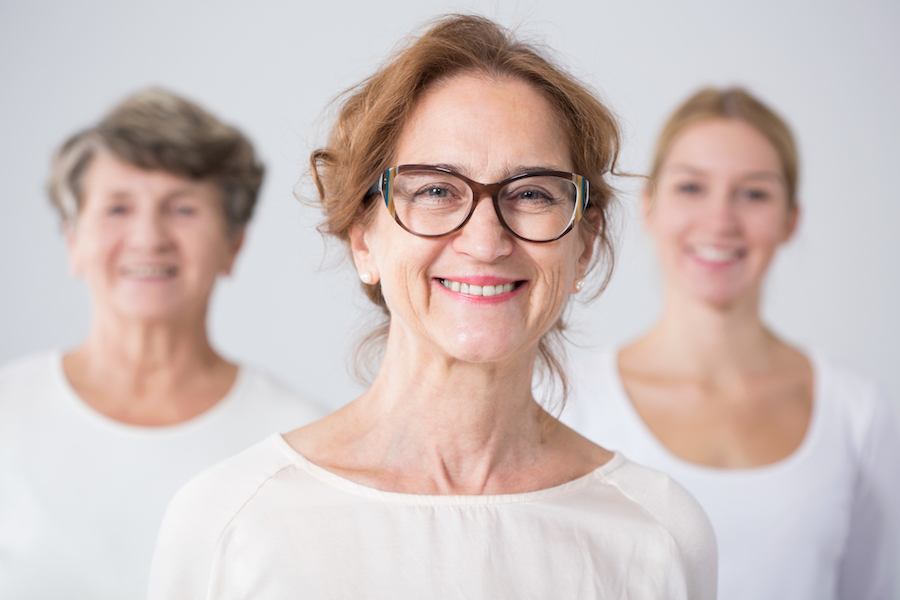This is what you need to do to keep your bones healthy, whatever your age
Healthy bones underpin – quite literally – so much of our overall health and fitness, but it’s easy to take them for granted.
Anyone can get osteoporosis – which causes weakened, fragile, fracture-prone bones – but women tend to be most affected, and the risk generally increases with age. According to the National Osteoporosis Society, one in two females and one in five men over 50 experience fractures, mostly due to low bone strength.
So, what can we do to look after our bone health? While osteoporosis might seem like something you only need to worry about once you reach a certain age, it’s never too early to start looking after yourself – in fact, the earlier the better. Here’s the experts’ advice for looking after your bones, whatever your age…

Low bone density can run in families
When you’re very young…
Our bones stop growing after a certain point, so our childhood and teens – plus our 20s, to a degree – play an important role when it comes to developing strong bones for life.
Professor David Reid, consultant rheumatologist and osteoporosis specialist at 25 Harley Street (25harleystreet.co.uk), points out that “more than 50% of the risk” comes from genetics – but lifestyle measures are certainly worthwhile, as they’ll help ensure you make the most of what nature’s given you.
“The message is, ‘Look after your bones’,” states Reid, who says there are three key points here, starting with “weight-bearing exercise, to maximise your potential bone mass”.
Unsure what weight-bearing exercise means? Not to be confused with weightlifting, it’s basically any exercise where you’re working against gravity – so things like walking, dancing, jogging, rather than things like swimming and cycling, where you’ve got the water or a bike supporting your weight.

Calcium is crucial for healthy bones
Of course, calcium is also crucial for healthy bones, and Reid says fad diets – especially those which advise cutting dairy products and fats – can be a concern in terms of teenage girls, who may be compromising their future bone health.
“Ensuring you take in enough dairy products, without being obsessive about whether it’s low-fat and so on, [is important],” he says. And if you do need or choose to use non-dairy alternatives, such as soya milk or nut milks, then make sure it’s supplemented with calcium.
“And then the other matter is vitamin D,” Reid adds. Essential for helping the body absorb calcium, lots of Brits are believed to be lacking in vitamin D, the so-called ‘sunshine vitamin’.
Reid says it’s important young people “get sufficient sun exposure [being sensible not to burn or damage your skin, of course], particularly in the summer months, because we know we often don’t get enough vitamin D from the sun in winter”.

Keeping strong and supple can help support the skeleton
In your 30s and 40s…
“Losing bone density is a normal part of the ageing process, and it will begin to fall from the age of 30. Some people lose bone density much faster than others, and this can lead to osteoporosis,” says Damian McClelland, clinical director of Musculoskeletal Services at Bupa (bupa.co.uk). “There are steps young women can take to guard against osteoporosis, such as maintaining a balanced, nutritious diet, which includes calcium-rich foods, such as cheese, sardines and leafy green vegetables like kale.”
Reid explains that, while your body will have stopped building bone mass by this stage, “you can certainly do the best you can in terms of maintaining it”. Again, plenty of calcium and vitamin D are essential (McClelland suggests topping up your dietary levels with “egg yolks and fatty fish such as salmon”), along with regular exercise.
“Pregnancy and breastfeeding put extra demands on a woman’s body that make it important for them to ensure they’re getting enough calcium,” adds McClelland. “When a baby’s in its mother’s womb, it needs plenty of calcium to develop its skeleton – and if the mother doesn’t take in enough, her baby will draw what it needs from her bones.”
Smoking is also known to be damaging for bone health, along with excessive alcohol consumption. Reid points out though, that “smoking cessation actually improves bone density” (in other words, it’s never too late to quit).

Keeping active is key, whatever your age
In your 50s, 60s and beyond…
“Women lose bone density rapidly in the first few years after the menopause,” says McClelland. “There are no symptoms in the early stages of bone loss, however, once someone’s bones have been weakened by osteoporosis, they may experience loss of height, a stooped posture, or back pain caused by a fractured or collapsed vertebra.”
Reid suggests women have a good chat with their GP about managing the menopause, and whether hormone replacement therapy (HRT) might be an option for them. He notes there are risk-assessment tools for calculating individual osteoporosis/fracture risk, and bone-density scans can be carried out, which – along with lifestyle considerations – can help determine how best to manage the condition if it develops. Some people might need medication, but a lot of the focus for this age group is around managing fracture risk.
Reid stresses that walking has been found to be beneficial for menopausal or older women in terms of bone density. “Doing something to build the muscles in the back would be useful [too],” he adds. “It’s not only about the bones, but building muscle strength and helping to keep the posture up.”

Walking – the world’s best exercise?
Keeping strong can also help with preventing falls – a big cause of fractures for those with osteoporosis. “Doing strengthening exercises like Pilates, yoga and body conditioning will reduce your fall risk,” notes Reid – but seek advice before starting any new exercise regime, particularly if you’ve already got a history of fractures, as there may be certain exercises you’ll need to avoid. Swimming can be a good choice for stretching and strengthening, for those needing to relieve pressure on the joints.
For anyone with back pain associated with the condition, McClelland adds: “This pain can be managed in different ways, including medication, heat and cold treatment, and relaxation techniques, including massages and hypnosis. Regular exercise can help to relieve stress, reduce fatigue and increase bone strength. However, they should avoid heavy exercises that require a lot of bending forward, as this could increase the risk of injury to the weakened spine.
“Although osteoporosis doesn’t affect how long it takes for a fracture to heal, a complicated wrist or hip fracture may require an operation to make sure the bone is set properly and heals in a good position,” he continues. “Making simple changes at home, including securing rugs and carpets, and keeping rubber mats by the sink and in the bath, will reduce the risk of slipping and a fracture occurring.”
The Press Association
Latest posts by The Press Association (see all)
- Beatles documentary Let It Be to be released on Disney+ - April 16, 2024
- How to keep your money safe – as criminals ramp up AI tactics to steal consumer data - April 16, 2024
- Seasoned marathon runners give their best race day tips for first-timers - April 16, 2024
- What are heat pumps and could they help your home save energy? - April 15, 2024
- Trailer for Bridgerton season three teases new friends-to-lovers romance - April 12, 2024





















